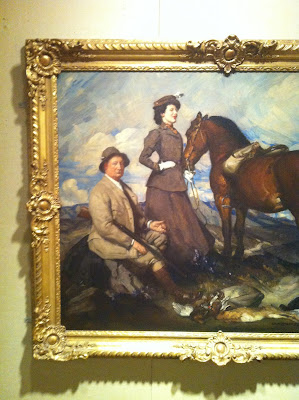The day before yesterday we installed Lady Curzon’s spectacular white satin “orchid” gown, one of a number that were created for her by the House of Worth. We know she wore it on state occasions in Delhi when she was Vicereine of India. The train is fourteen feet long, and, together with the bodice and skirt the entire ensemble was richly embroidered by Indian craftsmen and women with gold and silver threads and further augmented with faceted crystal beading that with the bullion shimmer under the lights. This indigenous technique is known as zardozi. Watching our colleague from the Fashion Museum at Bath perform the operation of dressing the dress was slightly eerie, as this sequence of photos will demonstrate, because one gradually began to sense more and more Mary Curzon’s ghostly presence, while also witnessing something of what it must have been like for a skilled lady’s maid to help her to get dressed. It would be impossible to do this without assistance. Naturally we began with a customized dummy on a stand.
The dummy and its precious cargo migrated from place to place throughout this procedure, which added to a vague but growing sense of imminence, but it was in the beginning dressed with a long calico petticoat to give some support the very fragile skirt.
Naturally
Lady Curzon wore additional foundation garments, including an up-to-the-minute boned and laced “s” corset, so this impression of the size of her waist (when so constricted) is actually quite
conservative.
Then came the bodice, very tight fitting and, like the skirt, extraordinarily heavy for its size (because of the bullion-work)...
...and finally the train, which you see here folded in three between layers of tissue paper. The front end of the train was secured with tapes around the waist, and these double bows finally tucked inside the front of the bodice.
This is the view that none of our visitors will have because I took the photograph through the rear of the case before it was firmly shut (for environmental control and light sensitivity). But it is helpful to explain why the train had to be arranged in this fluid manner, for to extend it fully would cause too much tension along the left edge. We had decided that it would be best to orient Lady Curzon to the front, a slightly less than three-quarters view, and to allow the train to create for her a graceful arc. Notice also that the skirt itself is possessed of a short but ample “bell” train on its own, so all the bullion-work and embroidery on the back of it is therefore mostly covered by the removable train.
Here she is, making a graceful turn. Lady Curzon must have had at least one page to assist her with the train, possibly two, and it was only worn for the most formal ceremonies. The pungent Indian iconography of sprays of orchids dominates the decoration of the skirt and bodice, but the train adds to this the more squarely English clusters of oak leaves and other British vice-regal heraldic devices, and fuses both in a sequence of classicizing wreaths around the edges that culminate in three very large ones at the end of the train. It is a truly remarkable hybrid. Very few exercises in art museum display have taught me as much or given me as much pleasure and fascination over three or four magical hours as did this gradual re-animation of Mary Curzon’s spectacular white satin “orchid” gown. Do please come and see it for yourselves.










.JPG)



